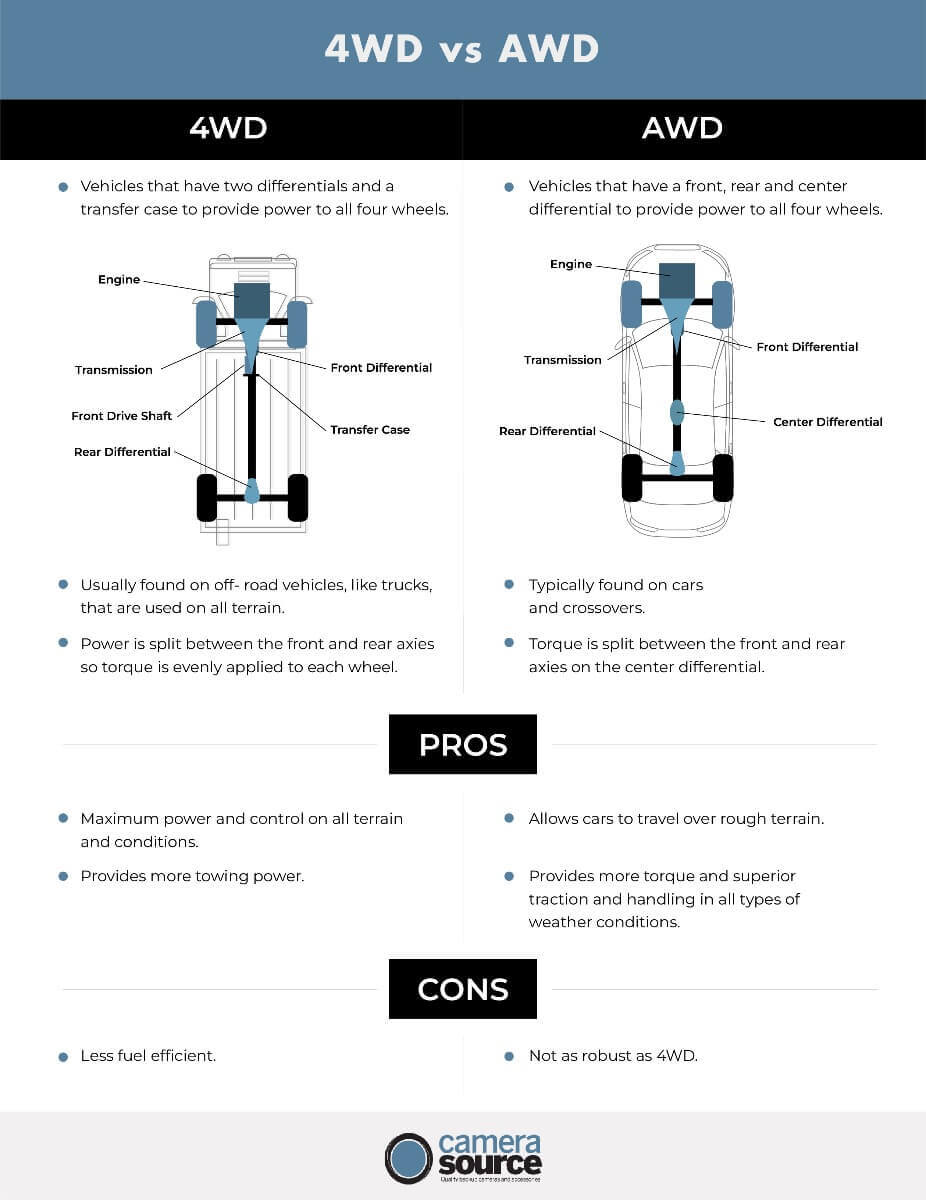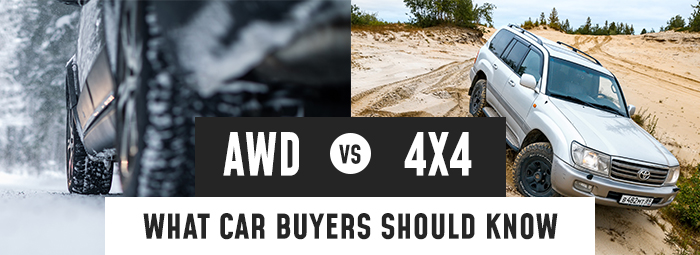Not sure about the difference between an all-wheel drive and a four-wheel drive vehicle? You’ve come to the right place. At Camera Source, we’re the backup camera experts, and we know a thing or two about the trucks that they’re used on. In this article, we’ll take you through the differences between both, as well as give you some suggestions for further qualities to look for.

What is all-wheel drive & four-wheel drive?
First, a little bit of definition. Whenever you hear “so-and-so drive”, that is referring to what type of torque you’re getting sent through the drivetrain of the vehicle. The drivetrain is the system of components that transfers energy from the engine or motor of the vehicle to the wheels. Sometimes you might hear the word powertrain used, which is not the same thing, as a powertrain includes the engine itself.
All-Wheel Drive, Defined
With an all-wheel drive vehicle, each of the wheels on the vehicle is powered independently, meaning they can all provide torque to the wheels. AWD vehicles have three differentials, or gear boxes, on the front, center, and rear, and these differentials mean your four tires can get traction independently of each other. This allows for superior traction and handling in all types of weather conditions.
Previously, all-wheel drive vehicles generally did not come with the option to be turned on and off, always delivering full power to all of the wheels to ensure maximum traction and handling, making them less fuel efficient than front or rear-wheel drive. Now, there are modern part-time AWD systems that use an array of electronic sensors that feed information to a computer to control the amount of power directed to each wheel.
There are two kinds of all-wheel-drive systems: full-time AWD, and part-time all-wheel-drive or an automatic AWD system.
Full-time AWD drives all four wheels continuously, while automatic AWD only uses AWD when necessary. Most of the time, part-time systems are in two-wheel-drive mode to conserve fuel, and switch to AWD only when traction is needed. Usually, part-time AWD sends torque to two driven wheels, either the front or rear, depending on the make and model. The system automatically engages the other two wheels when sensors indicate road conditions that demand extra traction.
Vehicles with AWD
The most common vehicles that come with all-wheel drive are SUVs and crossovers. However, there are multiple sedans, trucks, and minivans that have AWD. If you’re looking for a safe vehicle that will handle great in inclement weather and rough terrain, AWD vehicles offer a huge advantage. However, if you live in a city or an area with good weather year-round, AWD vehicles may not be the best option for you.
The same vehicles and drivers that benefit from AWD are the same who benefit from backup cameras for enhanced safety and confidence when backing into traffic, around corners, through crowded parking lots, or into a tight parking space.
4-Wheel Drive, Defined
4-wheel drive is very similar to all-wheel drive. With a 4WD vehicle, you have all four wheels operating at once, giving the driver maximum traction and the ability to keep moving through rough conditions, such as when off-roading.
Most 4WD systems can be turned on and off. This allows you to deploy the system for maximum fuel economy in many rough environments. It also is useful for people who work in rough conditions and need to turn on extra power for towing and other situations.
Vehicles with 4X4
Pickup trucks and Sport Utility Vehicles are the most common cars that come with 4WD. Not all SUVs have a 4X4 system, but most four-wheel drive vehicles fall within the SUV or crossover category, such as Jeeps.
If you’re considering purchasing a Jeep, make sure you equip it with backup and front and side cameras for maximum safety when off-roading, rock crawling, and adventuring.
AWD vs. 4x4: Which is better?
The answer to this question depends on your relative needs. Commonly, AWD systems are found on cars and family vehicles, designed to allow for maximum safety and control in a number of different environments and situations.
For families and folks who end up driving on a lot of rough roads, or wet and icy streets, AWD is likely the best choice. You’re forced to sacrifice fuel economy in exchange for safety and peace of mind.
4X4, on the other hand, is great for people who need to use their vehicle in tough environments, or for towing or other needs. If you’re looking for a truck that can handle a number of different scenarios, like towing, deep snow, off-roading, and rock crawling, a 4X4 vehicle is going to give you maximum control and allow you to do things like switch to 2-wheel drive, which is optimal for towing.
Do you need 4WD or AWD?
To get more granular about which type of vehicle drivetrain is best for you, there are some pretty important questions to ask yourself:
- What are you hauling? - Travel trailers, lumber, or utility trailers? Depending on what you’re going to be toting around with your vehicle, this could be the primary decision factor. If you’re not hauling anything regularly or at any other time, you might not need either. Many drivers prefer rear or front-wheel drive to 4WD and AWD because they feel that the vehicle handles better.
- How important is fuel economy to you? - If you’re worried about gas prices or want a vehicle that is as fuel efficient as possible, 4WD/AWD might not be the right choice, as these vehicles are far less fuel efficient and suited to long drives than other, lighter and less mechanically complex vehicles.
- What does the future hold for your vehicle needs? - Depending on where you live or where you might move in the future, a vehicle with all-terrain capability might be just what the doctor ordered. If you live in an area where it occasionally snows, or go up to the mountains for occasional winter sports, and still want good fuel economy, an AWD is a good choice. If you're frequently in snowy conditions, like to go on camping adventures, and/or expect to haul gear consistently, a 4WD system is ideal, at the sacrifice of some fuel economy.
Get the Right Camera for Your AWD or 4WD Vehicle
No matter the type of vehicle you’re driving, a quality backup camera is one of the best upgrades you can add to it to improve safety and overall comfort. At Camera Source, we have backup camera kits that can help you replace a broken backup camera on your vehicle, or install an entirely new one with a more high-definition monitor. Regardless of what backup camera you want, we can help you get what you need, and our helpful, knowledgeable staff is at the ready. Get in touch with us to learn more, or start browsing products today.








